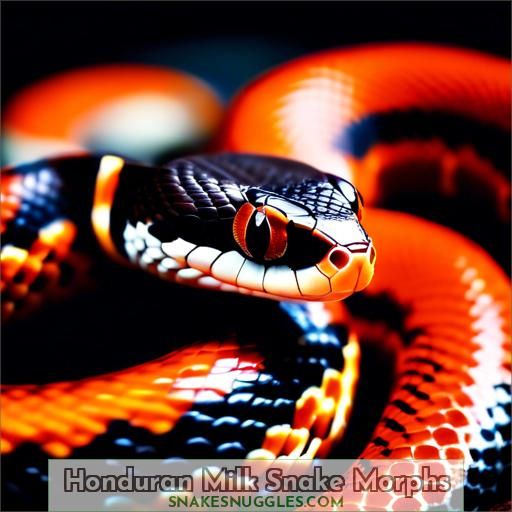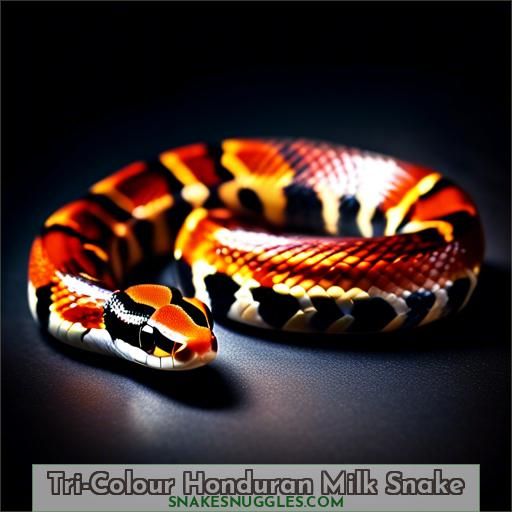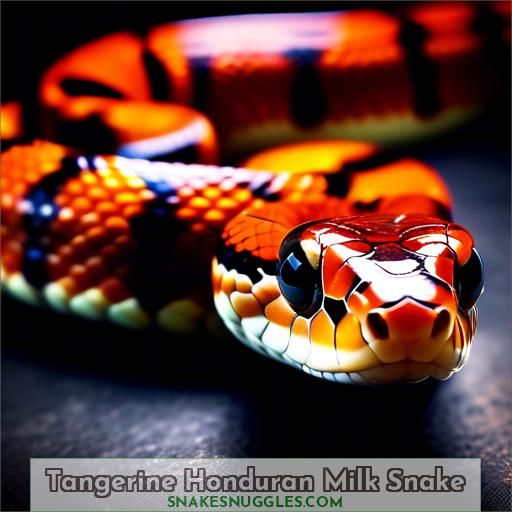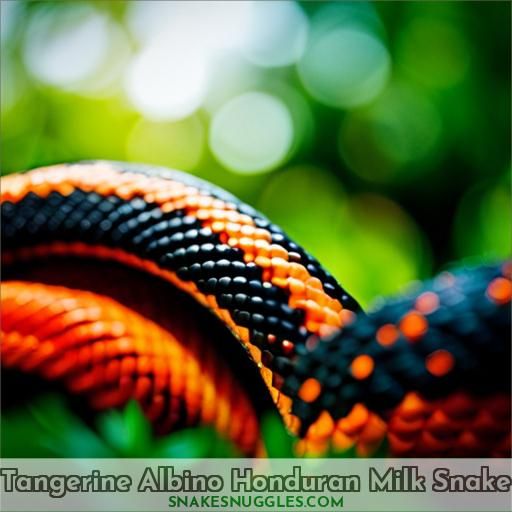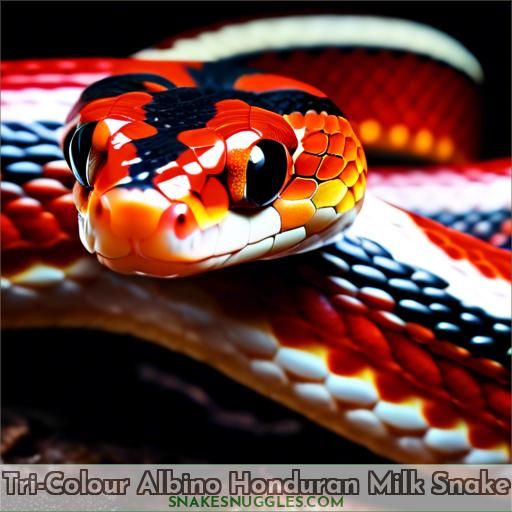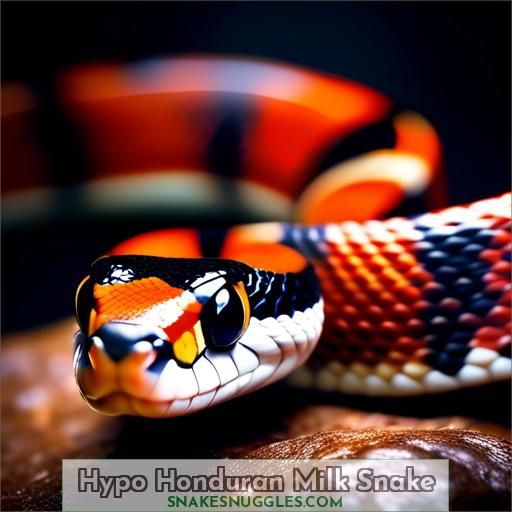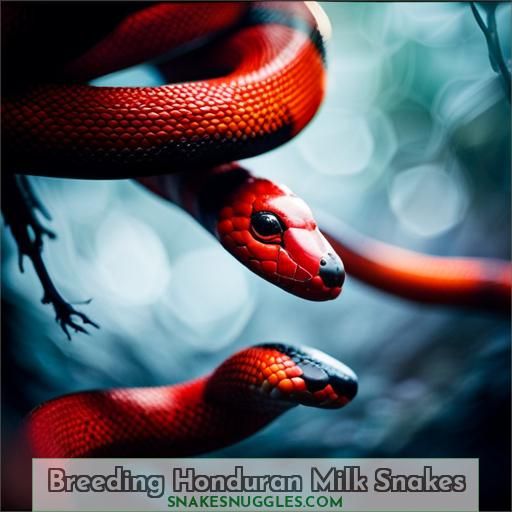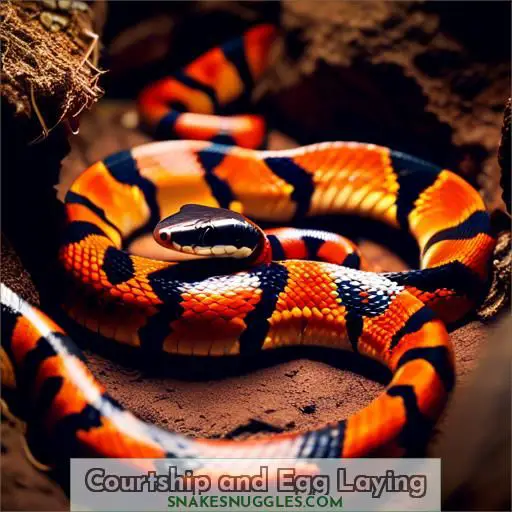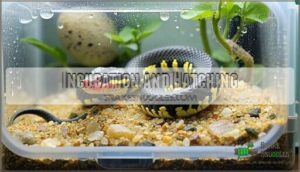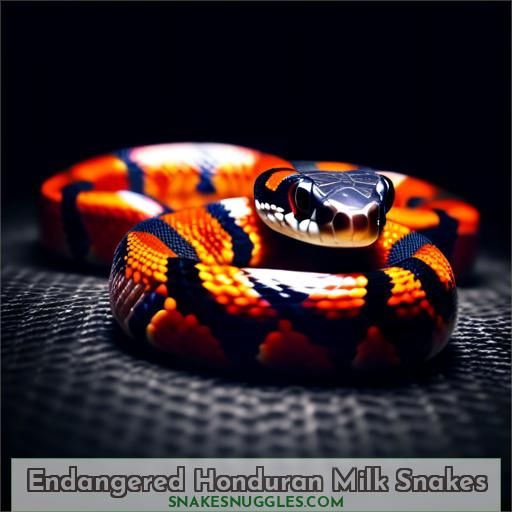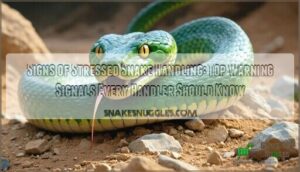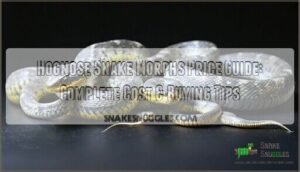This site is supported by our readers. We may earn a commission, at no cost to you, if you purchase through links.
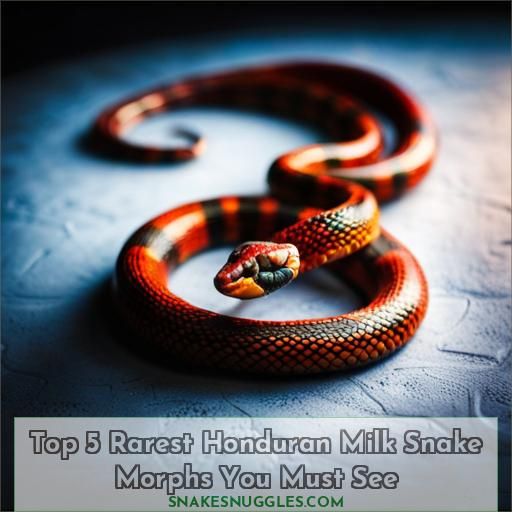
Honduran milk snakes mesmerize with their dazzling morphs!
The tri-color’s striking red, black, and white bands mimic venomous coral snakes.
Tangerines flaunt vibrant orange bases with orange inner rings.
Tri-color and tangerine albinos lack black pigment, revealing ruby-red eyes.
The hypo morph’s thin, clean bands fade beautifully.
Discover the allure of these top 5 honduran milk snake morphs – nature’s living artworks!
But why stop there? Prepare to be captivated by the intricate world of breeding these exquisite serpents.
Table Of Contents
- Key Takeaways
- Honduran Milk Snake Morphs
- Tri-Colour Honduran Milk Snake
- Tangerine Honduran Milk Snake
- Tangerine Albino Honduran Milk Snake
- Tri-Colour Albino Honduran Milk Snake
- Hypo Honduran Milk Snake
- Breeding Honduran Milk Snakes
- Courtship and Egg Laying
- Incubation and Hatching
- Endangered Honduran Milk Snakes
- Conclusion
Key Takeaways
- Honduran Milk Snakes are a captivating species of snake, known for their lively colors and intricate patterns.
- The top 5 Honduran Milk Snake morphs include Tri-color, Tangerine, Tangerine Albino, Tri-color Albino, and Hypo.
- Breeding Honduran Milk Snakes requires careful attention to their specific needs and conditions.
- Conservation efforts are essential to protect these snakes from extinction, as they are often confused with venomous species.
Honduran Milk Snake Morphs
Honduran Milk Snakes, also known as Honduran Red Milk Snakes, are a compelling species of snake, famous for their lively colors and intricate patterns. These snakes reside in Central America and belong to the Lampropeltis genus. They’re renowned for their tri-coloration, which includes red, black, and white or cream bands, as well as the tangerine morph, which features a bright orange base color. In this article, we’ll immerse ourselves in the fascinating world of Honduran Milk Snake morphs, exploring their unique characteristics and the genetic factors that give rise to their stunning appearances.
Tri-Color Honduran Milk Snakes, also referred to as the wild type, exhibit the classic coloration of this species. The background color ranges from red to orange, with inner rings that can be yellow or orange. The bands are outlined in black, and the snake may have a light-colored Y or V shape on its neck.
Tangerine Honduran Milk Snakes, on the other hand, have a more vibrant orange base color, with the inner rings being orange instead of yellow or white. This morph is also known for its striking appearance, which is a result of the selective breeding in captivity that has enhanced the tangerine color.
Albino Honduran Milk Snakes, including Tangerine Albino and Tri-Color Albino morphs, are characterized by the absence of black pigmentation. Tangerine Albino snakes have red eyes and orange bands between the white bands, which may be the same color or brighter than the base orange. Tri-Color Albino snakes have yellow bands between the white, creating more contrast than the Tangerine Albino.
Hypo Honduran Milk Snakes are a hypomelanistic morph, meaning they’ve very thin, clean bands with a faded, pastel-like appearance. These snakes often have a lighter coloration than the wild type or other morphs.
In addition to these morphs, there are other selectively bred lines of Honduran Milk Snakes that are becoming available, such as Striped and Aberrant, Ghost, and Hybino. These morphs showcase the remarkable genetic diversity of this species and the endless possibilities for breeding new and unique colorations.
In the next subtopic, we’ll explore the Tri-Colour Honduran Milk Snake, a particularly striking morph of this species that’s highly sought after by snake enthusiasts.
Tri-Colour Honduran Milk Snake
The Tri-Color Honduran Milk Snake is a stunning morph with its unique tri-color patterns.
These snakes are native to the Honduran habitats and are known for their ability to mimic the venomous coral snake.
With their smooth scales and 19-23 rows, they’re a sight to behold.
Conservation efforts are essential to protect these snakes from extinction, as they’re often confused with venomous species.
Their tri-color albino morph is another top 5 Honduran Milk Snake Morph, showcasing their distinctiveness.
Milk snakes and kingsnakes are closely related, but the Tri-Color Honduran Milk Snake is a must-have for any snake enthusiast looking for a unique appearance.
Tangerine Honduran Milk Snake
The Tangerine Honduran Milk Snake morph is an alluring variation of the Honduran Milk Snake.
Renowned for its vivid orange coloration, this morph exhibits distinctive scale patterns that distinguish it from others.
Habitat disparities between Tangerine and other Honduran Milk Snakes are negligible.
However, dietary preferences might differ slightly.
Conservation endeavors are paramount to safeguard these magnificent creatures and their habitats.
Tangerine Albino Honduran Milk Snake
Just when you thought the Tangerine Honduran Milk Snake was a showstopper, along comes its dazzling cousin, the Tangerine Albino Honduran Milk Snake. This morph takes the cake with its vibrant hues and unique genetics. Here’s why it’s a must-have:
- Its tangerine color is even more pronounced due to the albino genetics.
- Breeding these beauties is like hitting the genetic jackpot.
- They’re a proof of the power of selective breeding.
- Their striking appearance commands attention in any collection.
- Owning one feels like having a piece of the sun itself.
This snake isn’t just a pet; it’s a statement of mastery and control over the art of breeding.
Tri-Colour Albino Honduran Milk Snake
The Tri-Color Albino Honduran Milk Snake is an enchanting morph with a singular combination of colors.
Its tri-color variations, including white-sided tri-color, are an outcome of genetic variation and selective breeding.
This snake’s geographic distribution extends from Central America to the southern United States, encompassing different subspecies such as the Pueblan Milk Snake, Eastern Milk Snake, and Red Milk Snake.
The Tri-Color Albino Honduran Milk Snake’s coloration is a reflection of nature’s splendor, with its white, yellow, and orange bands mirroring the patterns of other snakes, a type of mimicry that enhances its charm.
Hypo Honduran Milk Snake
Striking Honduran Milk Snakes are a captivating and unique morph of the Honduran Milk Snake, known for their striking contrasts in coloration. As a hypo morph, they’ve a reduced number of scales, which can lead to a more vibrant and intricate pattern. Here’s how to care for your Striking Honduran Milk Snake:
- Striking Honduran Care**: Provide a warm and humid environment, with temperatures ranging from 72-80°F on the warm side and 65-72°F on the cool side.
- Striking Honduran Habitat**: Offer a 48x24x24 enclosure, filled with natural hiding spots and decorations.
- Striking Honduran Behavior**: These snakes are active and curious, so provide plenty of toys and enrichment.
- Striking Honduran Diet**: Feed a varied diet of rodents, lizards, and eggs.
Breeding Honduran Milk Snakes
Breeding Honduran Milk Snakes can be a rewarding endeavor for those who are passionate about these beautiful and unique creatures. These snakes are renowned for their vibrant colors and impressive size, making them a popular choice for many reptile enthusiasts. However, breeding them requires careful attention to their specific needs and conditions.
For a proper setup, consider a 10-gallon enclosure for juveniles and 20-70 gallons for adults, as recommended in the Snake Care Guide for Milk Snakes. Firstly, it’s critical to provide an enclosure of appropriate size for your Honduran Milk Snakes. As they grow larger, they require more space to move around comfortably. A minimum enclosure size of 48 inches long, 12 inches wide, and 16 inches tall is recommended for adults, while juveniles can be housed in smaller enclosures.
Next, consider the variety of food for your snakes. Honduran Milk Snakes are carnivores and prefer a diet of rodents, such as frozen-thawed mice as recommended in a milk snake care sheet. Honduran Milk Snakes are carnivores and prefer a diet of rodents, such as mice and rats. They may also consume other snakes, lizards, and eggs. Feeding schedules should be adjusted based on the snake’s age and size. For example, adults can be fed once every eight to ten days, while growing hatchlings should be fed every four to six days.
When it comes to heating and humidity, Honduran Milk Snakes require specific conditions. The warm side of their enclosure should be around 82°F, while the cool side should be around 75°F. The hottest zone shouldn’t exceed 86°F. These snakes don’t need to bask, so there’s no need to provide a basking area in their enclosure. However, they do require a heat source, such as an under-tank heater or heat lamp, to maintain the desired temperature range.
Humidity levels should be maintained around 50-60% to ensure proper shedding and overall health. A hygrometer can be used to monitor humidity levels, and a humid hide should be provided for shedding.
Breeding Honduran Milk Snakes can be challenging, as they’re known to be cannibalistic. Consequently, it’s advisable to house them individually unless during mating season. Females should be at least 3 feet long before breeding, while males can be bred at a younger age.
During the breeding season, which typically occurs from March to May, females will lay pheromone trails to attract males. Once mating occurs, females will lay 2-17 eggs about 30 days after copulation. Eggs should be incubated in an incubator at 84°F, and hatching usually takes around 60 days.
Breeding Honduran Milk Snakes can be a fascinating experience for those who are dedicated to their care and well-being. By providing the right conditions and attention, you can assist these snakes in thriving and contribute to the preservation of their species.
Courtship and Egg Laying
Courtship and egg laying in Honduran Milk Snakes is a captivating process. These snakes are renowned for their elaborate courtship rituals, which involve the males performing a sequence of displays to entice females. The males will frequently vibrate their tails, emit a musk, and strike to showcase their dominance. Once a female has selected a partner, she’ll deposit her eggs in an appropriate location, typically within a burrow or beneath a hiding spot. The eggs are subsequently incubated for approximately 60 days prior to hatching.
During the egg-laying process, the female will frequently search for a suitable location, such as a burrow or a concealed spot in the enclosure. She’ll then lay her eggs, typically around 4 to 12 large eggs, and will often return to the same location to lay her subsequent clutch of eggs. The eggs are then incubated, typically within a humid environment, and the eggs should be maintained at a temperature of around 29-30°C for optimal hatching success.
Parental care isn’t a significant factor in Honduran Milk Snakes, as they’re oviparous, meaning they lay eggs and don’t provide care for their young after hatching. The hatchlings are left to fend for themselves and will need to find food and shelter on their own.
In terms of lighting, Honduran Milk Snakes don’t require UVB lighting, but they do benefit from low-level lighting to help maintain a day/night cycle. Full-spectrum lighting can also help enhance the colors of the snakes. It’s imperative to maintain the appropriate temperature gradients in the enclosure, with the warm end around 86-90°F and the cool end around 76-80°F, to ensure the snakes are comfortable and healthy.
Incubation and Hatching
After the courtship dance, the real magic begins.
You’re now the guardian of potential life, overseeing the incubation period where every second counts.
With egg handling, think surgeon’s precision—any misstep could compromise egg viability.
Your incubator becomes a cradle of creation, maintaining just-right humidity levels to avoid the tragedy of desiccation.
Tick-tock, the incubation time is a 60-day test of patience.
But the reward? A hatchling, your living proof of mastery over the delicate art of snake breeding.
Endangered Honduran Milk Snakes
The Honduran Milk Snake, a native of Central America, is a species that has faced various threats in its natural habitat. Habitat loss, human persecution, and road mortality are some of the primary concerns for the safeguarding of these snakes. Despite being common in their native habitat, their population numbers are affected by these threats, which can impact their long-term survival.
Milk snakes are often confused with venomous species such as coral snakes, and this misidentification can lead to their persecution. To minimize this risk, it’s essential to monitor the population and actively work in the direction of milksnake conservation. This can include educating the public about the differences between venomous and non-venomous snakes, as well as implementing measures to protect their habitats and reduce road mortality.
The future outlook for Honduran Milk Snakes isn’t entirely bleak. With proper conservation efforts and habitat protection, it’s possible to preserve their populations and make certain their survival in the wild. As a species, they’ve shown resilience and adaptability, which gives hope for their future.
Conclusion
Enthralled? With 1.5 million captive Honduran milk snakes worldwide, these exquisite serpents captivate reptile aficionados. Discover the enchanting realm of the top 5 Honduran milk snake morphs – tangerine, tri-color albino, and more. Delve into intricate breeding methods, witness mesmerizing courtship rituals, and experience the unparalleled exhilaration of incubating nature’s precious eggs. Embrace your passion; these slithering masterpieces await your dedicated care.

